MGMT1101: Final Project - Research & Analysis of Starbucks Management
VerifiedAdded on 2022/09/06
|10
|2130
|160
Report
AI Summary
This report provides a comprehensive analysis of Starbucks' management strategies, organizational structure, and performance. The report begins with a summary of Starbucks' business, including its value proposition and revenue generation. It then delves into a detailed SWOT analysis, identifying the company's strengths, weaknesses, opportunities, and threats, and formulates strategies based on these findings. The report also examines the environmental constraints impacting Starbucks, including political, economic, social, technological, legal, and environmental factors. Furthermore, it analyzes the company's stakeholders, organizational structure (identifying it as mechanistic), and employee motivation techniques, highlighting the importance of intrinsic rewards. Finally, the report discusses control measures and recommendations for effective strategy implementation, suggesting the use of concurrent control and offering advice on expansion and technology transfer to suppliers. The report concludes with a summary of the key findings and recommendations for Starbucks' continued success.
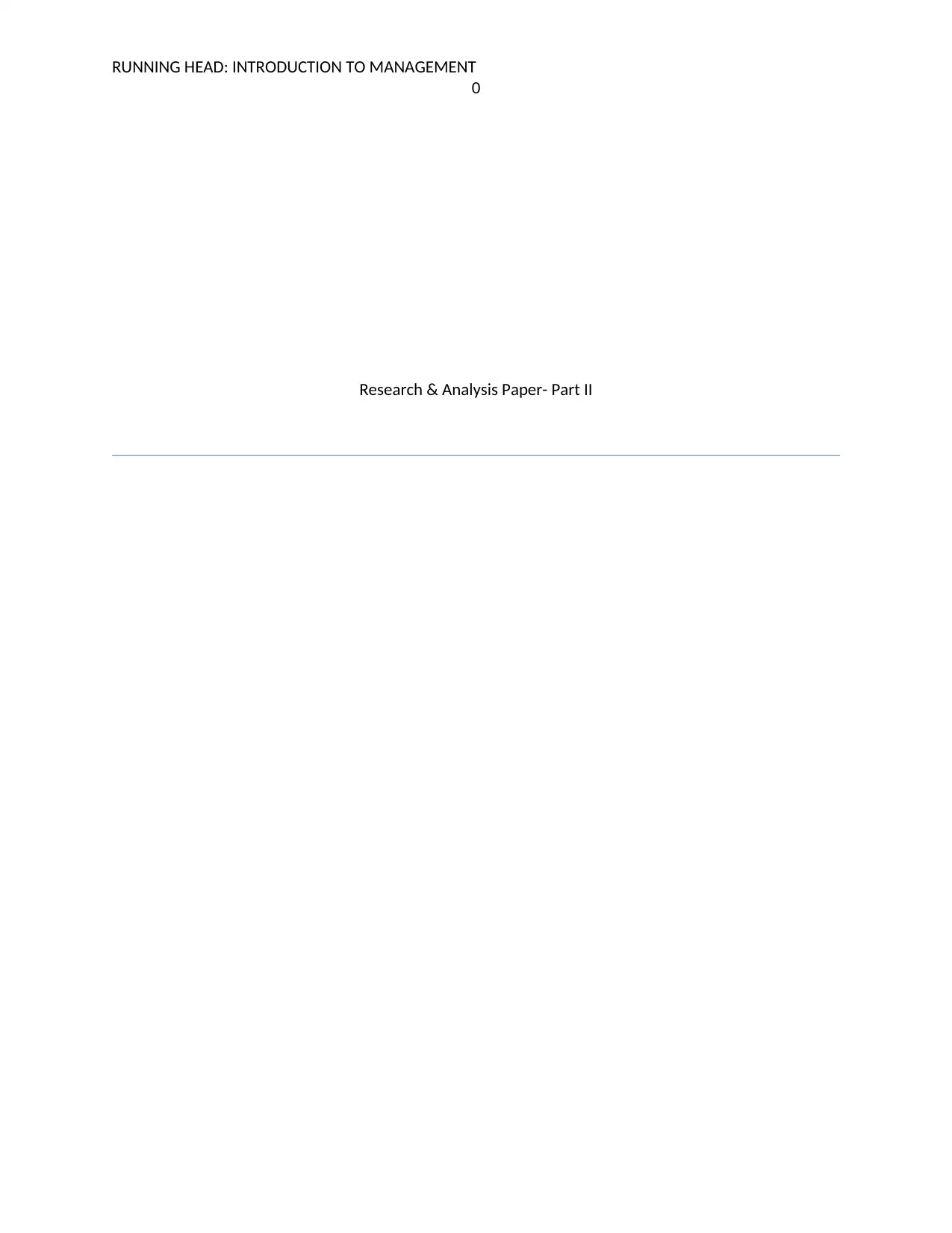
RUNNING HEAD: INTRODUCTION TO MANAGEMENT
0
Research & Analysis Paper- Part II
0
Research & Analysis Paper- Part II
Paraphrase This Document
Need a fresh take? Get an instant paraphrase of this document with our AI Paraphraser
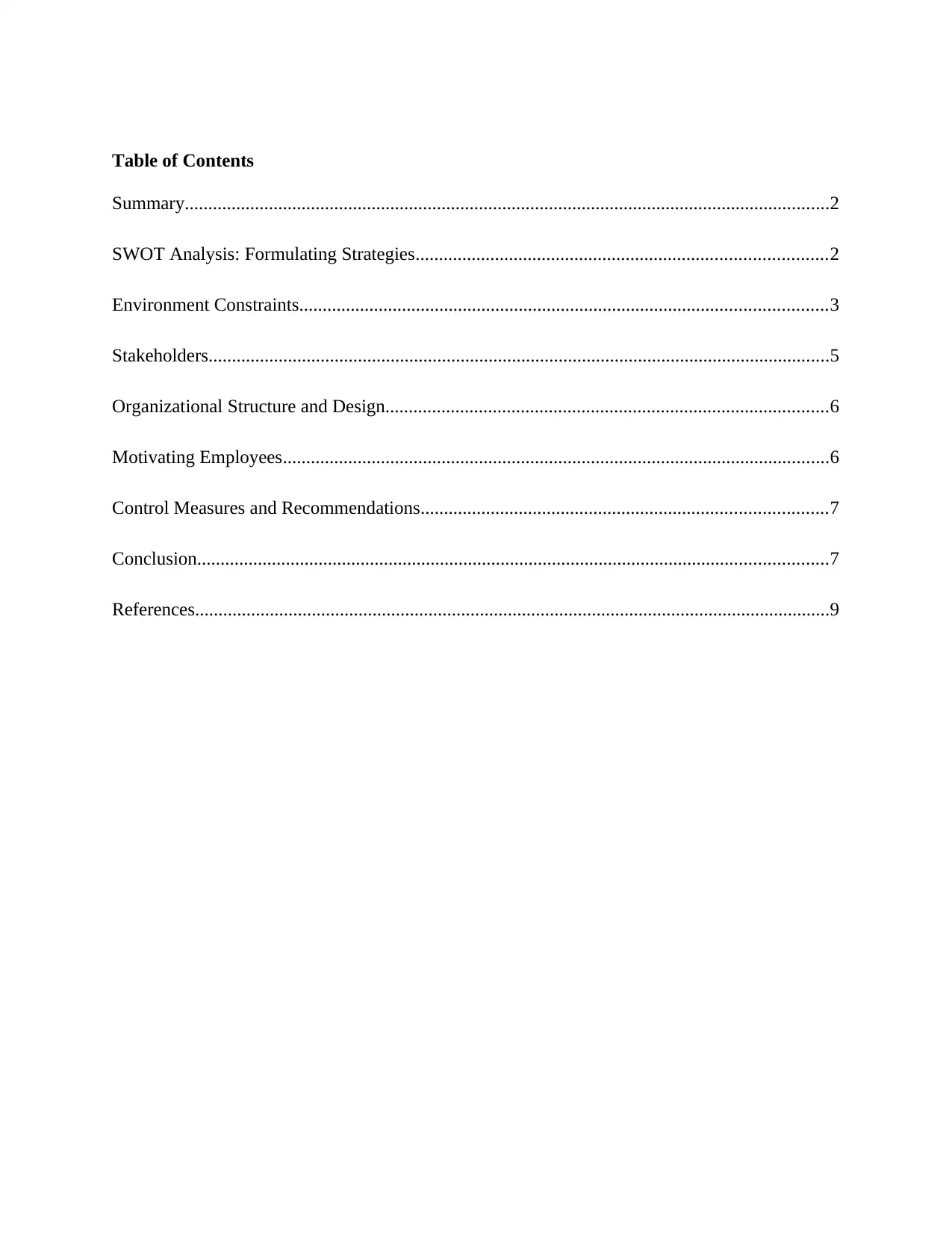
Table of Contents
Summary..........................................................................................................................................2
SWOT Analysis: Formulating Strategies........................................................................................2
Environment Constraints.................................................................................................................3
Stakeholders.....................................................................................................................................5
Organizational Structure and Design...............................................................................................6
Motivating Employees.....................................................................................................................6
Control Measures and Recommendations.......................................................................................7
Conclusion.......................................................................................................................................7
References........................................................................................................................................9
Summary..........................................................................................................................................2
SWOT Analysis: Formulating Strategies........................................................................................2
Environment Constraints.................................................................................................................3
Stakeholders.....................................................................................................................................5
Organizational Structure and Design...............................................................................................6
Motivating Employees.....................................................................................................................6
Control Measures and Recommendations.......................................................................................7
Conclusion.......................................................................................................................................7
References........................................................................................................................................9
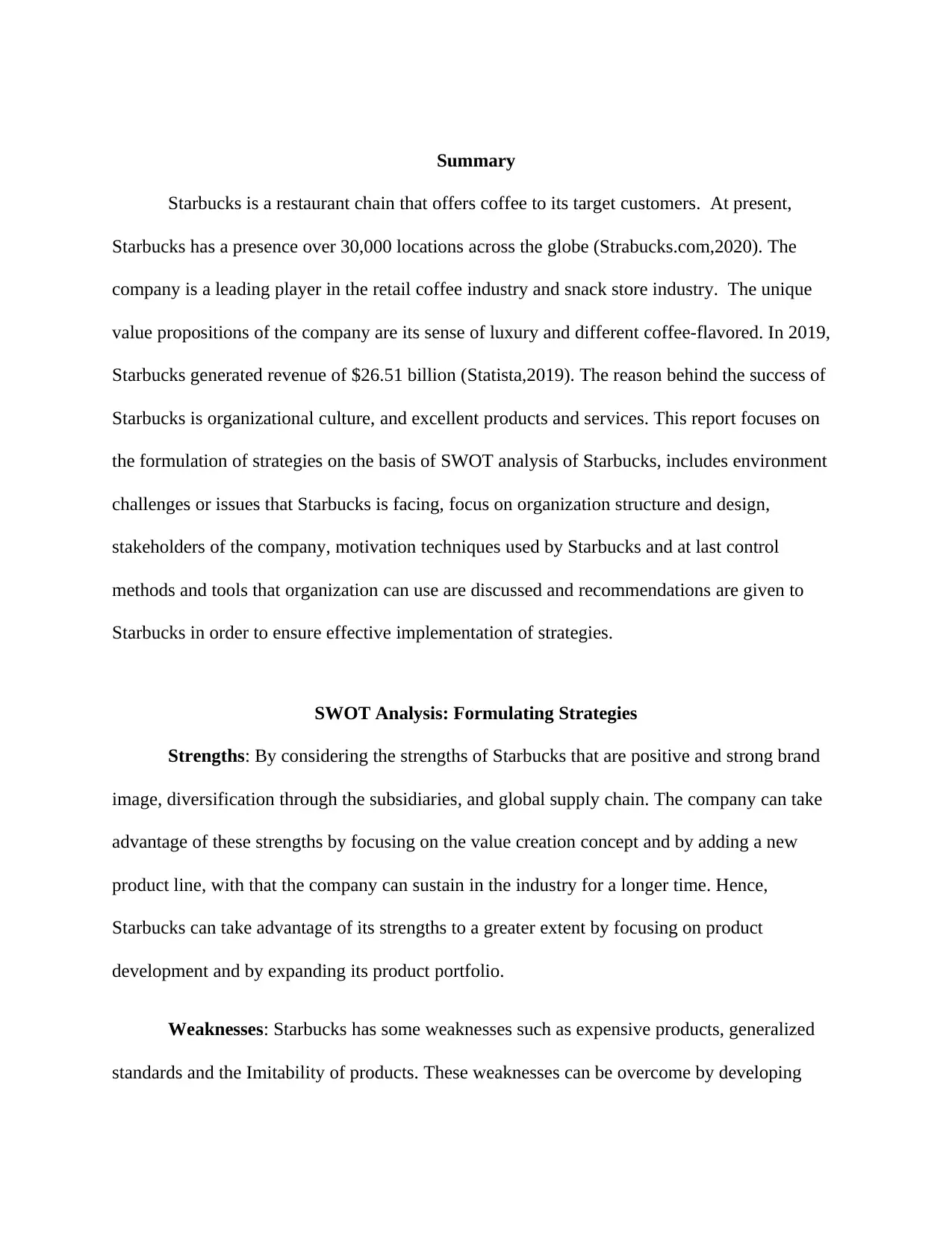
Summary
Starbucks is a restaurant chain that offers coffee to its target customers. At present,
Starbucks has a presence over 30,000 locations across the globe (Strabucks.com,2020). The
company is a leading player in the retail coffee industry and snack store industry. The unique
value propositions of the company are its sense of luxury and different coffee-flavored. In 2019,
Starbucks generated revenue of $26.51 billion (Statista,2019). The reason behind the success of
Starbucks is organizational culture, and excellent products and services. This report focuses on
the formulation of strategies on the basis of SWOT analysis of Starbucks, includes environment
challenges or issues that Starbucks is facing, focus on organization structure and design,
stakeholders of the company, motivation techniques used by Starbucks and at last control
methods and tools that organization can use are discussed and recommendations are given to
Starbucks in order to ensure effective implementation of strategies.
SWOT Analysis: Formulating Strategies
Strengths: By considering the strengths of Starbucks that are positive and strong brand
image, diversification through the subsidiaries, and global supply chain. The company can take
advantage of these strengths by focusing on the value creation concept and by adding a new
product line, with that the company can sustain in the industry for a longer time. Hence,
Starbucks can take advantage of its strengths to a greater extent by focusing on product
development and by expanding its product portfolio.
Weaknesses: Starbucks has some weaknesses such as expensive products, generalized
standards and the Imitability of products. These weaknesses can be overcome by developing
Starbucks is a restaurant chain that offers coffee to its target customers. At present,
Starbucks has a presence over 30,000 locations across the globe (Strabucks.com,2020). The
company is a leading player in the retail coffee industry and snack store industry. The unique
value propositions of the company are its sense of luxury and different coffee-flavored. In 2019,
Starbucks generated revenue of $26.51 billion (Statista,2019). The reason behind the success of
Starbucks is organizational culture, and excellent products and services. This report focuses on
the formulation of strategies on the basis of SWOT analysis of Starbucks, includes environment
challenges or issues that Starbucks is facing, focus on organization structure and design,
stakeholders of the company, motivation techniques used by Starbucks and at last control
methods and tools that organization can use are discussed and recommendations are given to
Starbucks in order to ensure effective implementation of strategies.
SWOT Analysis: Formulating Strategies
Strengths: By considering the strengths of Starbucks that are positive and strong brand
image, diversification through the subsidiaries, and global supply chain. The company can take
advantage of these strengths by focusing on the value creation concept and by adding a new
product line, with that the company can sustain in the industry for a longer time. Hence,
Starbucks can take advantage of its strengths to a greater extent by focusing on product
development and by expanding its product portfolio.
Weaknesses: Starbucks has some weaknesses such as expensive products, generalized
standards and the Imitability of products. These weaknesses can be overcome by developing
⊘ This is a preview!⊘
Do you want full access?
Subscribe today to unlock all pages.

Trusted by 1+ million students worldwide
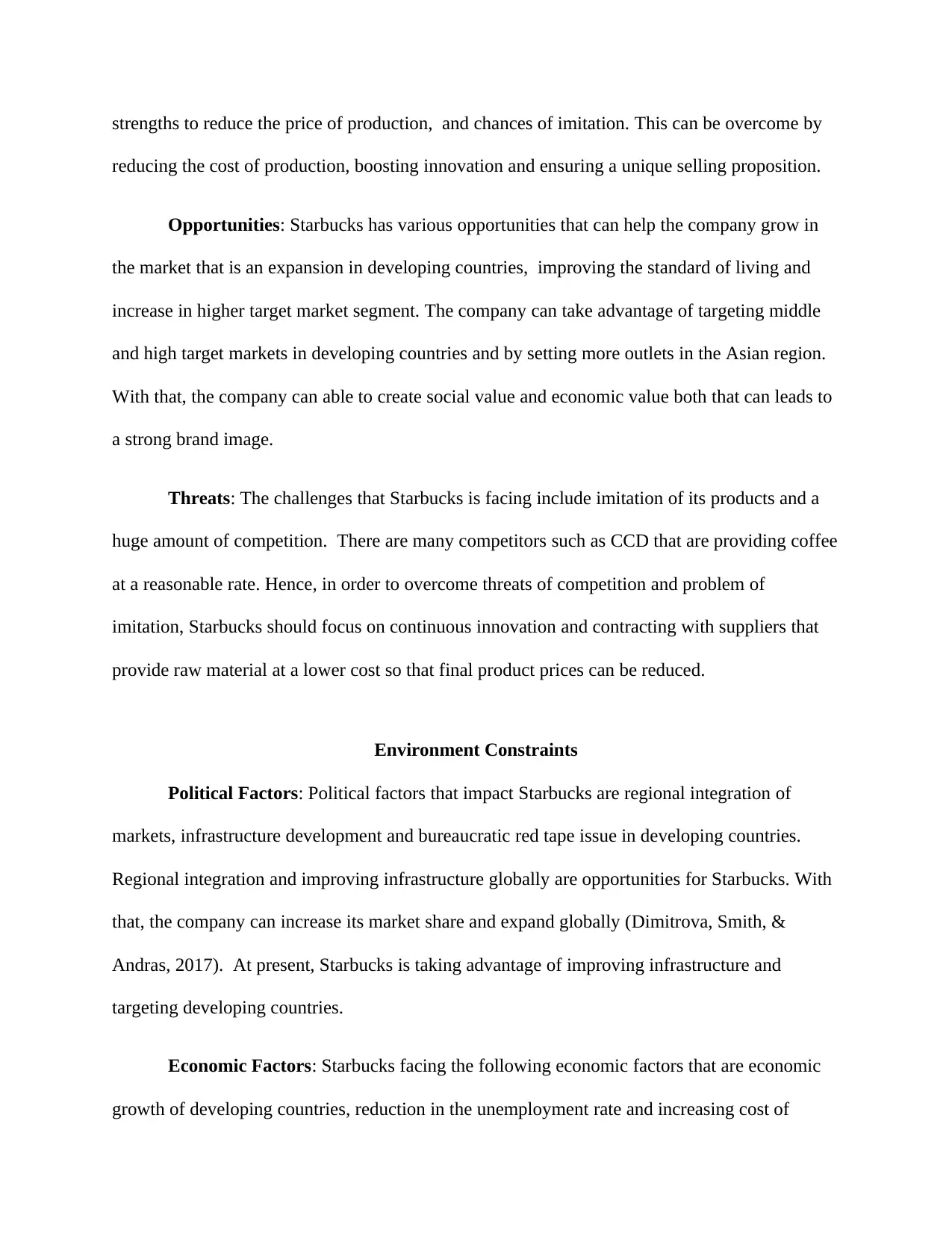
strengths to reduce the price of production, and chances of imitation. This can be overcome by
reducing the cost of production, boosting innovation and ensuring a unique selling proposition.
Opportunities: Starbucks has various opportunities that can help the company grow in
the market that is an expansion in developing countries, improving the standard of living and
increase in higher target market segment. The company can take advantage of targeting middle
and high target markets in developing countries and by setting more outlets in the Asian region.
With that, the company can able to create social value and economic value both that can leads to
a strong brand image.
Threats: The challenges that Starbucks is facing include imitation of its products and a
huge amount of competition. There are many competitors such as CCD that are providing coffee
at a reasonable rate. Hence, in order to overcome threats of competition and problem of
imitation, Starbucks should focus on continuous innovation and contracting with suppliers that
provide raw material at a lower cost so that final product prices can be reduced.
Environment Constraints
Political Factors: Political factors that impact Starbucks are regional integration of
markets, infrastructure development and bureaucratic red tape issue in developing countries.
Regional integration and improving infrastructure globally are opportunities for Starbucks. With
that, the company can increase its market share and expand globally (Dimitrova, Smith, &
Andras, 2017). At present, Starbucks is taking advantage of improving infrastructure and
targeting developing countries.
Economic Factors: Starbucks facing the following economic factors that are economic
growth of developing countries, reduction in the unemployment rate and increasing cost of
reducing the cost of production, boosting innovation and ensuring a unique selling proposition.
Opportunities: Starbucks has various opportunities that can help the company grow in
the market that is an expansion in developing countries, improving the standard of living and
increase in higher target market segment. The company can take advantage of targeting middle
and high target markets in developing countries and by setting more outlets in the Asian region.
With that, the company can able to create social value and economic value both that can leads to
a strong brand image.
Threats: The challenges that Starbucks is facing include imitation of its products and a
huge amount of competition. There are many competitors such as CCD that are providing coffee
at a reasonable rate. Hence, in order to overcome threats of competition and problem of
imitation, Starbucks should focus on continuous innovation and contracting with suppliers that
provide raw material at a lower cost so that final product prices can be reduced.
Environment Constraints
Political Factors: Political factors that impact Starbucks are regional integration of
markets, infrastructure development and bureaucratic red tape issue in developing countries.
Regional integration and improving infrastructure globally are opportunities for Starbucks. With
that, the company can increase its market share and expand globally (Dimitrova, Smith, &
Andras, 2017). At present, Starbucks is taking advantage of improving infrastructure and
targeting developing countries.
Economic Factors: Starbucks facing the following economic factors that are economic
growth of developing countries, reduction in the unemployment rate and increasing cost of
Paraphrase This Document
Need a fresh take? Get an instant paraphrase of this document with our AI Paraphraser
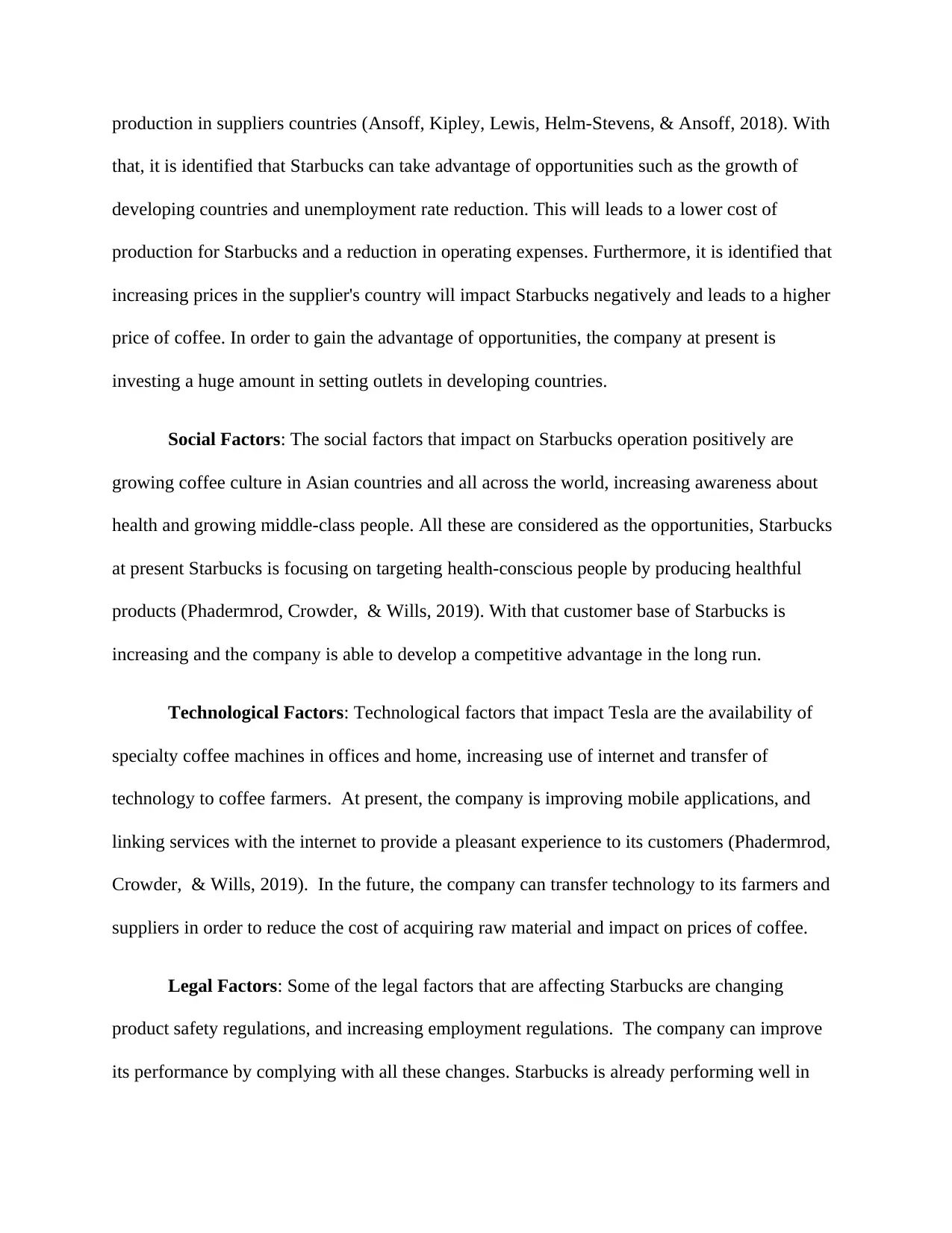
production in suppliers countries (Ansoff, Kipley, Lewis, Helm-Stevens, & Ansoff, 2018). With
that, it is identified that Starbucks can take advantage of opportunities such as the growth of
developing countries and unemployment rate reduction. This will leads to a lower cost of
production for Starbucks and a reduction in operating expenses. Furthermore, it is identified that
increasing prices in the supplier's country will impact Starbucks negatively and leads to a higher
price of coffee. In order to gain the advantage of opportunities, the company at present is
investing a huge amount in setting outlets in developing countries.
Social Factors: The social factors that impact on Starbucks operation positively are
growing coffee culture in Asian countries and all across the world, increasing awareness about
health and growing middle-class people. All these are considered as the opportunities, Starbucks
at present Starbucks is focusing on targeting health-conscious people by producing healthful
products (Phadermrod, Crowder, & Wills, 2019). With that customer base of Starbucks is
increasing and the company is able to develop a competitive advantage in the long run.
Technological Factors: Technological factors that impact Tesla are the availability of
specialty coffee machines in offices and home, increasing use of internet and transfer of
technology to coffee farmers. At present, the company is improving mobile applications, and
linking services with the internet to provide a pleasant experience to its customers (Phadermrod,
Crowder, & Wills, 2019). In the future, the company can transfer technology to its farmers and
suppliers in order to reduce the cost of acquiring raw material and impact on prices of coffee.
Legal Factors: Some of the legal factors that are affecting Starbucks are changing
product safety regulations, and increasing employment regulations. The company can improve
its performance by complying with all these changes. Starbucks is already performing well in
that, it is identified that Starbucks can take advantage of opportunities such as the growth of
developing countries and unemployment rate reduction. This will leads to a lower cost of
production for Starbucks and a reduction in operating expenses. Furthermore, it is identified that
increasing prices in the supplier's country will impact Starbucks negatively and leads to a higher
price of coffee. In order to gain the advantage of opportunities, the company at present is
investing a huge amount in setting outlets in developing countries.
Social Factors: The social factors that impact on Starbucks operation positively are
growing coffee culture in Asian countries and all across the world, increasing awareness about
health and growing middle-class people. All these are considered as the opportunities, Starbucks
at present Starbucks is focusing on targeting health-conscious people by producing healthful
products (Phadermrod, Crowder, & Wills, 2019). With that customer base of Starbucks is
increasing and the company is able to develop a competitive advantage in the long run.
Technological Factors: Technological factors that impact Tesla are the availability of
specialty coffee machines in offices and home, increasing use of internet and transfer of
technology to coffee farmers. At present, the company is improving mobile applications, and
linking services with the internet to provide a pleasant experience to its customers (Phadermrod,
Crowder, & Wills, 2019). In the future, the company can transfer technology to its farmers and
suppliers in order to reduce the cost of acquiring raw material and impact on prices of coffee.
Legal Factors: Some of the legal factors that are affecting Starbucks are changing
product safety regulations, and increasing employment regulations. The company can improve
its performance by complying with all these changes. Starbucks is already performing well in
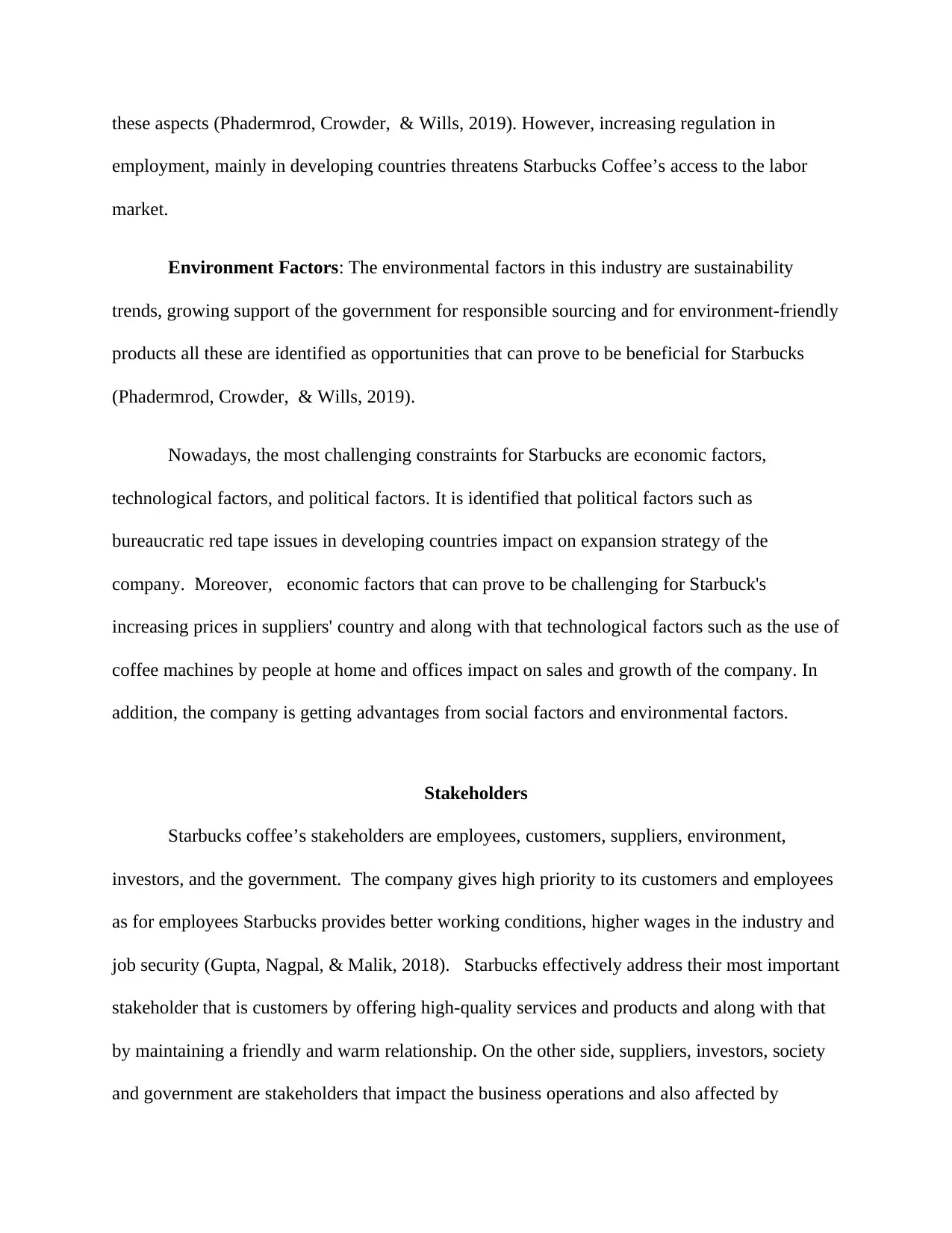
these aspects (Phadermrod, Crowder, & Wills, 2019). However, increasing regulation in
employment, mainly in developing countries threatens Starbucks Coffee’s access to the labor
market.
Environment Factors: The environmental factors in this industry are sustainability
trends, growing support of the government for responsible sourcing and for environment-friendly
products all these are identified as opportunities that can prove to be beneficial for Starbucks
(Phadermrod, Crowder, & Wills, 2019).
Nowadays, the most challenging constraints for Starbucks are economic factors,
technological factors, and political factors. It is identified that political factors such as
bureaucratic red tape issues in developing countries impact on expansion strategy of the
company. Moreover, economic factors that can prove to be challenging for Starbuck's
increasing prices in suppliers' country and along with that technological factors such as the use of
coffee machines by people at home and offices impact on sales and growth of the company. In
addition, the company is getting advantages from social factors and environmental factors.
Stakeholders
Starbucks coffee’s stakeholders are employees, customers, suppliers, environment,
investors, and the government. The company gives high priority to its customers and employees
as for employees Starbucks provides better working conditions, higher wages in the industry and
job security (Gupta, Nagpal, & Malik, 2018). Starbucks effectively address their most important
stakeholder that is customers by offering high-quality services and products and along with that
by maintaining a friendly and warm relationship. On the other side, suppliers, investors, society
and government are stakeholders that impact the business operations and also affected by
employment, mainly in developing countries threatens Starbucks Coffee’s access to the labor
market.
Environment Factors: The environmental factors in this industry are sustainability
trends, growing support of the government for responsible sourcing and for environment-friendly
products all these are identified as opportunities that can prove to be beneficial for Starbucks
(Phadermrod, Crowder, & Wills, 2019).
Nowadays, the most challenging constraints for Starbucks are economic factors,
technological factors, and political factors. It is identified that political factors such as
bureaucratic red tape issues in developing countries impact on expansion strategy of the
company. Moreover, economic factors that can prove to be challenging for Starbuck's
increasing prices in suppliers' country and along with that technological factors such as the use of
coffee machines by people at home and offices impact on sales and growth of the company. In
addition, the company is getting advantages from social factors and environmental factors.
Stakeholders
Starbucks coffee’s stakeholders are employees, customers, suppliers, environment,
investors, and the government. The company gives high priority to its customers and employees
as for employees Starbucks provides better working conditions, higher wages in the industry and
job security (Gupta, Nagpal, & Malik, 2018). Starbucks effectively address their most important
stakeholder that is customers by offering high-quality services and products and along with that
by maintaining a friendly and warm relationship. On the other side, suppliers, investors, society
and government are stakeholders that impact the business operations and also affected by
⊘ This is a preview!⊘
Do you want full access?
Subscribe today to unlock all pages.

Trusted by 1+ million students worldwide
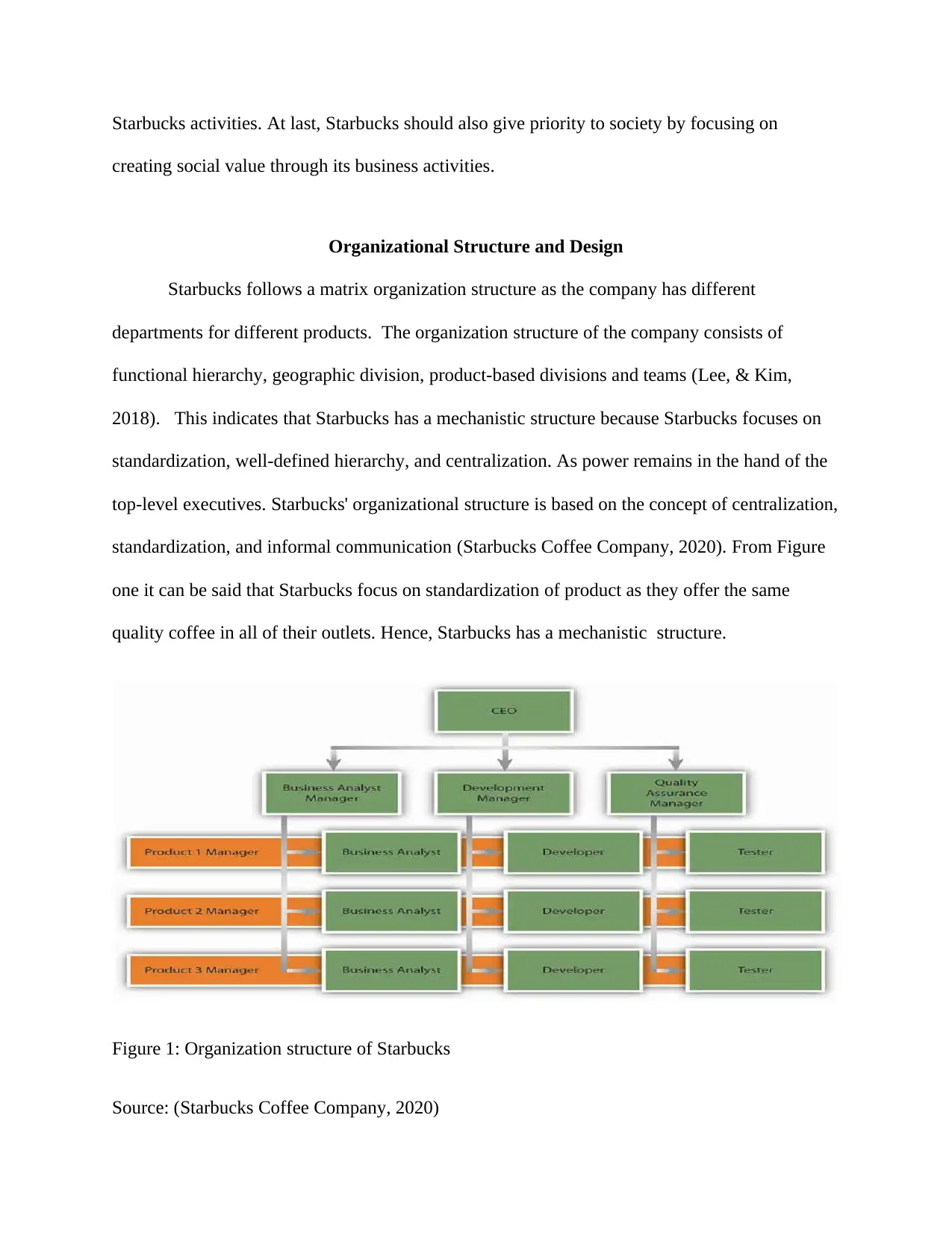
Starbucks activities. At last, Starbucks should also give priority to society by focusing on
creating social value through its business activities.
Organizational Structure and Design
Starbucks follows a matrix organization structure as the company has different
departments for different products. The organization structure of the company consists of
functional hierarchy, geographic division, product-based divisions and teams (Lee, & Kim,
2018). This indicates that Starbucks has a mechanistic structure because Starbucks focuses on
standardization, well-defined hierarchy, and centralization. As power remains in the hand of the
top-level executives. Starbucks' organizational structure is based on the concept of centralization,
standardization, and informal communication (Starbucks Coffee Company, 2020). From Figure
one it can be said that Starbucks focus on standardization of product as they offer the same
quality coffee in all of their outlets. Hence, Starbucks has a mechanistic structure.
Figure 1: Organization structure of Starbucks
Source: (Starbucks Coffee Company, 2020)
creating social value through its business activities.
Organizational Structure and Design
Starbucks follows a matrix organization structure as the company has different
departments for different products. The organization structure of the company consists of
functional hierarchy, geographic division, product-based divisions and teams (Lee, & Kim,
2018). This indicates that Starbucks has a mechanistic structure because Starbucks focuses on
standardization, well-defined hierarchy, and centralization. As power remains in the hand of the
top-level executives. Starbucks' organizational structure is based on the concept of centralization,
standardization, and informal communication (Starbucks Coffee Company, 2020). From Figure
one it can be said that Starbucks focus on standardization of product as they offer the same
quality coffee in all of their outlets. Hence, Starbucks has a mechanistic structure.
Figure 1: Organization structure of Starbucks
Source: (Starbucks Coffee Company, 2020)
Paraphrase This Document
Need a fresh take? Get an instant paraphrase of this document with our AI Paraphraser
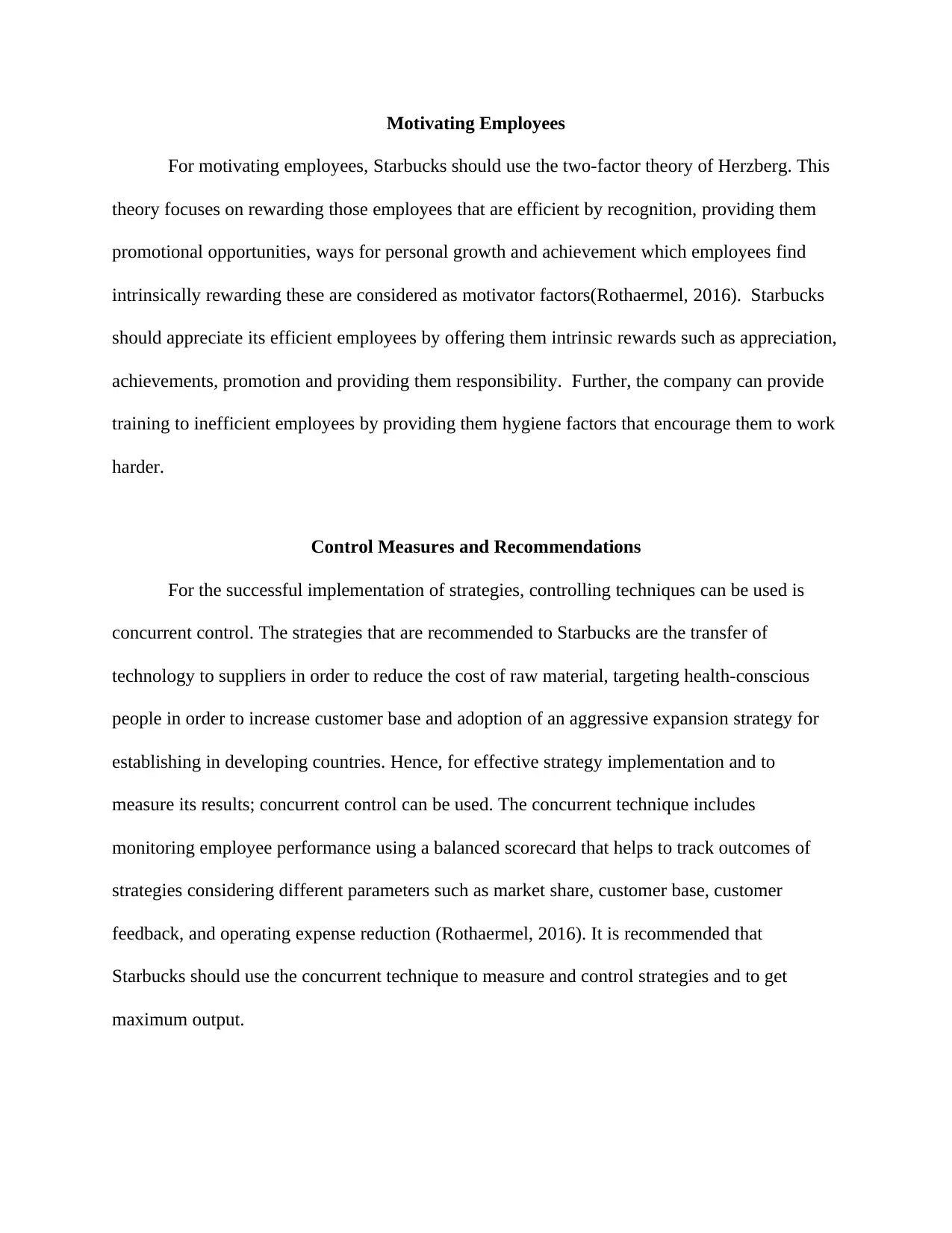
Motivating Employees
For motivating employees, Starbucks should use the two-factor theory of Herzberg. This
theory focuses on rewarding those employees that are efficient by recognition, providing them
promotional opportunities, ways for personal growth and achievement which employees find
intrinsically rewarding these are considered as motivator factors(Rothaermel, 2016). Starbucks
should appreciate its efficient employees by offering them intrinsic rewards such as appreciation,
achievements, promotion and providing them responsibility. Further, the company can provide
training to inefficient employees by providing them hygiene factors that encourage them to work
harder.
Control Measures and Recommendations
For the successful implementation of strategies, controlling techniques can be used is
concurrent control. The strategies that are recommended to Starbucks are the transfer of
technology to suppliers in order to reduce the cost of raw material, targeting health-conscious
people in order to increase customer base and adoption of an aggressive expansion strategy for
establishing in developing countries. Hence, for effective strategy implementation and to
measure its results; concurrent control can be used. The concurrent technique includes
monitoring employee performance using a balanced scorecard that helps to track outcomes of
strategies considering different parameters such as market share, customer base, customer
feedback, and operating expense reduction (Rothaermel, 2016). It is recommended that
Starbucks should use the concurrent technique to measure and control strategies and to get
maximum output.
For motivating employees, Starbucks should use the two-factor theory of Herzberg. This
theory focuses on rewarding those employees that are efficient by recognition, providing them
promotional opportunities, ways for personal growth and achievement which employees find
intrinsically rewarding these are considered as motivator factors(Rothaermel, 2016). Starbucks
should appreciate its efficient employees by offering them intrinsic rewards such as appreciation,
achievements, promotion and providing them responsibility. Further, the company can provide
training to inefficient employees by providing them hygiene factors that encourage them to work
harder.
Control Measures and Recommendations
For the successful implementation of strategies, controlling techniques can be used is
concurrent control. The strategies that are recommended to Starbucks are the transfer of
technology to suppliers in order to reduce the cost of raw material, targeting health-conscious
people in order to increase customer base and adoption of an aggressive expansion strategy for
establishing in developing countries. Hence, for effective strategy implementation and to
measure its results; concurrent control can be used. The concurrent technique includes
monitoring employee performance using a balanced scorecard that helps to track outcomes of
strategies considering different parameters such as market share, customer base, customer
feedback, and operating expense reduction (Rothaermel, 2016). It is recommended that
Starbucks should use the concurrent technique to measure and control strategies and to get
maximum output.
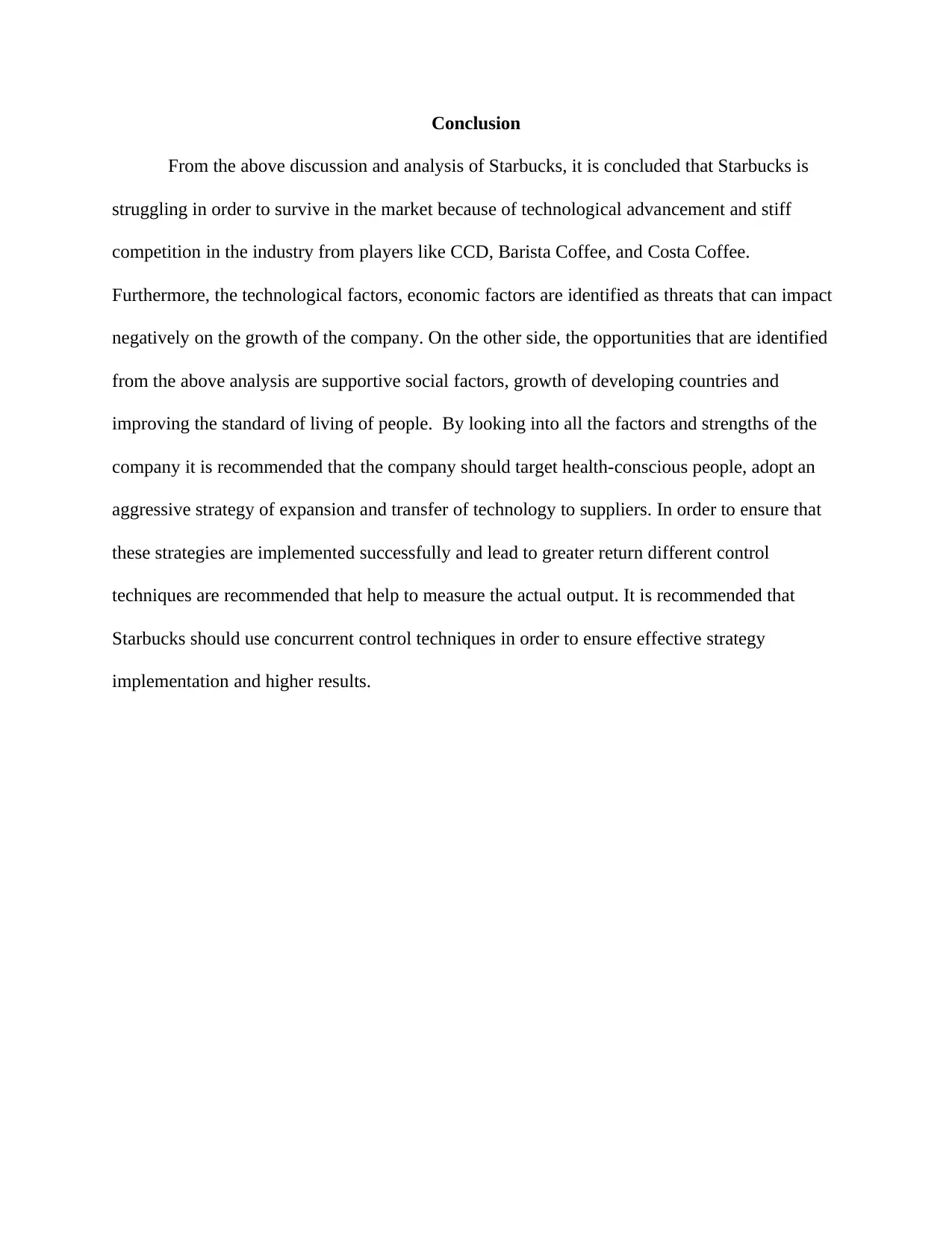
Conclusion
From the above discussion and analysis of Starbucks, it is concluded that Starbucks is
struggling in order to survive in the market because of technological advancement and stiff
competition in the industry from players like CCD, Barista Coffee, and Costa Coffee.
Furthermore, the technological factors, economic factors are identified as threats that can impact
negatively on the growth of the company. On the other side, the opportunities that are identified
from the above analysis are supportive social factors, growth of developing countries and
improving the standard of living of people. By looking into all the factors and strengths of the
company it is recommended that the company should target health-conscious people, adopt an
aggressive strategy of expansion and transfer of technology to suppliers. In order to ensure that
these strategies are implemented successfully and lead to greater return different control
techniques are recommended that help to measure the actual output. It is recommended that
Starbucks should use concurrent control techniques in order to ensure effective strategy
implementation and higher results.
From the above discussion and analysis of Starbucks, it is concluded that Starbucks is
struggling in order to survive in the market because of technological advancement and stiff
competition in the industry from players like CCD, Barista Coffee, and Costa Coffee.
Furthermore, the technological factors, economic factors are identified as threats that can impact
negatively on the growth of the company. On the other side, the opportunities that are identified
from the above analysis are supportive social factors, growth of developing countries and
improving the standard of living of people. By looking into all the factors and strengths of the
company it is recommended that the company should target health-conscious people, adopt an
aggressive strategy of expansion and transfer of technology to suppliers. In order to ensure that
these strategies are implemented successfully and lead to greater return different control
techniques are recommended that help to measure the actual output. It is recommended that
Starbucks should use concurrent control techniques in order to ensure effective strategy
implementation and higher results.
⊘ This is a preview!⊘
Do you want full access?
Subscribe today to unlock all pages.

Trusted by 1+ million students worldwide
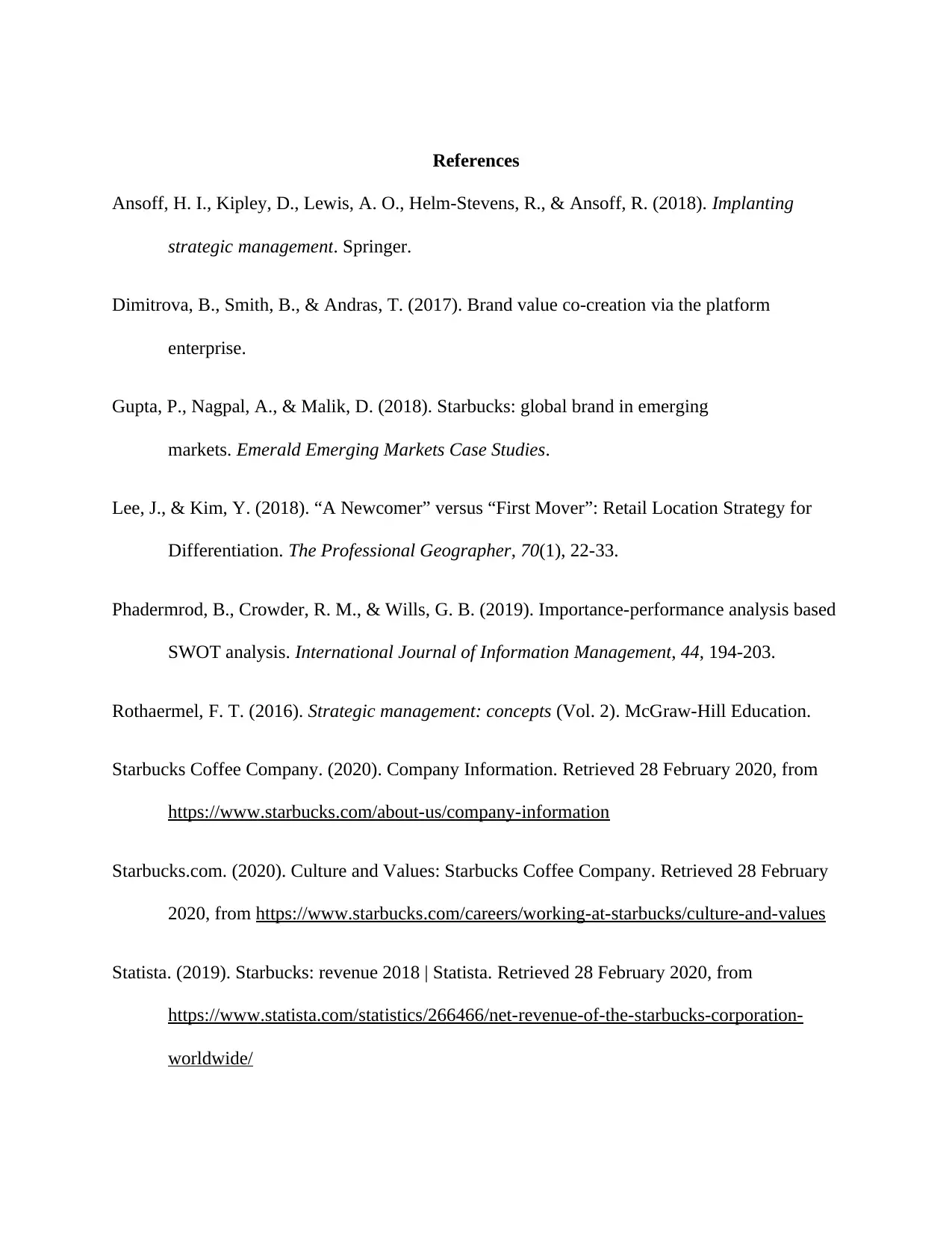
References
Ansoff, H. I., Kipley, D., Lewis, A. O., Helm-Stevens, R., & Ansoff, R. (2018). Implanting
strategic management. Springer.
Dimitrova, B., Smith, B., & Andras, T. (2017). Brand value co-creation via the platform
enterprise.
Gupta, P., Nagpal, A., & Malik, D. (2018). Starbucks: global brand in emerging
markets. Emerald Emerging Markets Case Studies.
Lee, J., & Kim, Y. (2018). “A Newcomer” versus “First Mover”: Retail Location Strategy for
Differentiation. The Professional Geographer, 70(1), 22-33.
Phadermrod, B., Crowder, R. M., & Wills, G. B. (2019). Importance-performance analysis based
SWOT analysis. International Journal of Information Management, 44, 194-203.
Rothaermel, F. T. (2016). Strategic management: concepts (Vol. 2). McGraw-Hill Education.
Starbucks Coffee Company. (2020). Company Information. Retrieved 28 February 2020, from
https://www.starbucks.com/about-us/company-information
Starbucks.com. (2020). Culture and Values: Starbucks Coffee Company. Retrieved 28 February
2020, from https://www.starbucks.com/careers/working-at-starbucks/culture-and-values
Statista. (2019). Starbucks: revenue 2018 | Statista. Retrieved 28 February 2020, from
https://www.statista.com/statistics/266466/net-revenue-of-the-starbucks-corporation-
worldwide/
Ansoff, H. I., Kipley, D., Lewis, A. O., Helm-Stevens, R., & Ansoff, R. (2018). Implanting
strategic management. Springer.
Dimitrova, B., Smith, B., & Andras, T. (2017). Brand value co-creation via the platform
enterprise.
Gupta, P., Nagpal, A., & Malik, D. (2018). Starbucks: global brand in emerging
markets. Emerald Emerging Markets Case Studies.
Lee, J., & Kim, Y. (2018). “A Newcomer” versus “First Mover”: Retail Location Strategy for
Differentiation. The Professional Geographer, 70(1), 22-33.
Phadermrod, B., Crowder, R. M., & Wills, G. B. (2019). Importance-performance analysis based
SWOT analysis. International Journal of Information Management, 44, 194-203.
Rothaermel, F. T. (2016). Strategic management: concepts (Vol. 2). McGraw-Hill Education.
Starbucks Coffee Company. (2020). Company Information. Retrieved 28 February 2020, from
https://www.starbucks.com/about-us/company-information
Starbucks.com. (2020). Culture and Values: Starbucks Coffee Company. Retrieved 28 February
2020, from https://www.starbucks.com/careers/working-at-starbucks/culture-and-values
Statista. (2019). Starbucks: revenue 2018 | Statista. Retrieved 28 February 2020, from
https://www.statista.com/statistics/266466/net-revenue-of-the-starbucks-corporation-
worldwide/
1 out of 10
Related Documents
Your All-in-One AI-Powered Toolkit for Academic Success.
+13062052269
info@desklib.com
Available 24*7 on WhatsApp / Email
![[object Object]](/_next/static/media/star-bottom.7253800d.svg)
Unlock your academic potential
Copyright © 2020–2025 A2Z Services. All Rights Reserved. Developed and managed by ZUCOL.




